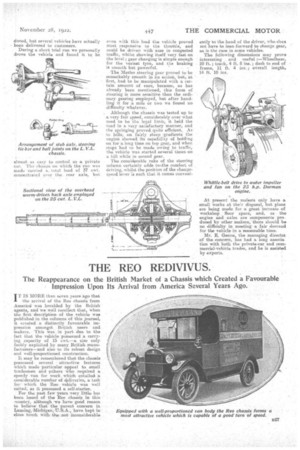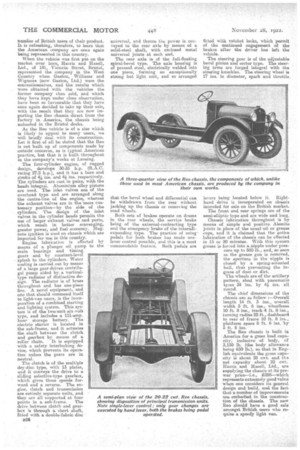THE REO REDIVIVUS.
Page 11

Page 12

If you've noticed an error in this article please click here to report it so we can fix it.
The Reappearance on the British Market of a Chassis which Created a Favourable Impression Upon Its Arrival from America Several Years Ago.
T IS MORE than seven years Ago that
the arrival of the Bee chassis from America was heralded by the British agents, and we well recollect that, when the first description of the vehicle was published in the columns of this journal, it created a distinctly favourable impression amongst British .users and makers. This was in part chic to the fact that the vehicle Tossess,ed a carrying capacity of 15 cwt.—a size only feebly exploited, by many. British manufacturers—and also to its robust design arid well-proportioned construction.
It may be reinembered that the chassis possessed several • attractive features which made particular appeal to small. tradesmen and yetbers who required a speedy van for work. which entailed a congiderable number of deliveries, a task for which the Rao vehicle was well suited, as it possessed a self-starter.
For the past few years very little has been heard of the Rae chassis in this ...van-try, although vie havegoOd reason to believe, that the •parent concern in Lansing;Michigan,-II,S.A., have kept in close touch witsthe not intonsiderable
number of British users of their product. It is refreshing, therefore, to learn that the American company are once again being represented in this country.
When the vehicle was first put on the market over here, Harris and Hese11, Ltd., of 141, Victoria Street, Bristol, represented the -company in the West Country when. Gaston, Williams and Wigmore (now Gaston, Ltd.) were the concession-liaises, and the results which were obtained with the vehicles the former company then sold, and which they have kept under close observation, have been so favourable that they have once again decided to take up their sale, with the result that they are now importing the Reo chassis direct from the factory in America, the chassis being unloaded in. the Bristol docks.
As the Ras vehicle is of a size which is likely to appeal to many users, we will briefly deal with its construction. Let it first of all be stated that the Reo is not built up of components made by outside concerns, as is typical American practice, but that it is built throughout in the company's works at Lansing.
The four-cylinder engine, of rugged design, develops 30,35 h.p. (R.A.C. rating 27.2 h.p.), and it has a bore and stroke of 41 ins. and 4i ins. respectively. The cylinders are cast, in pairs, -with the heads integral. Aluminium alloy pistons are used. The inlet valves are of the overhead type and are arranged along the centre-line of the engine, whereas the exhaust valves are in the more customary position—by the side of the cylinders. The design of the inlet valves in the cylinder heads permits the use of larger exhaust valves and ports, which result in better scavenging, greater power, and fuel economy. Magneto isnition is used on chassis which are imported for use in this country. Engine lubrication is effected by means of a plunger oil pump to the main bearings and timing gears and, by constant-level splash to the cylinders. Water cooling is carriel out by means of a large gear-driven centrifugal pump aided by. a verticaltype radiator of distinctive design. The radiator is of brass throughout and has one-piece fins. A novel equipment, and oile that should commend itself to light-van users, is the incorporation of a combined starting and lighting system. This system is of the two-unit six-volt tyrie, and includes a 111-amp. hour storage battery. The electric starter is located in the sub-frame, and it actuates the shaft between the clutch and gearbox by means of a
roller chain. It is equipped with a safety interlocking device, which prevents its operation unless the gears are in neutral.
The clutch is of the multiple dry-disc type, with 13 plates, and it conveys the drive to a sliding selective-type gearbox, which gives three speeds forward and a reverse. The engine, clutch and transmission are entirely separate units, and they are all supported at four
points in a. sub-frame. The drive between clutch and gearbox is through a short shaft, fitted with a. double-fabric disc
B2S • universal, and thence the power is conveyed to the rear axle by means of a solid-steel shaft, with enclosed metal universal joints at each end.
The rear axle is of the full-floating spiral-bevel type. The axle housing is of pressed steel, electrically welded into one piece, forming an exceptionally strong but light unit, and so arranged that the bevel wheel and differential can be withdrawn from the rear without jacking up the chassis or removing the road wheels.
Both sets of brakes operate on drums in the rear wheels, the service brake being of the external-contracting type and the emergency brake of the internillexpanding type. The practice of using ' pedals for bath brakes has made one lever control possible, and this is a most commendable feature. Both pedals are fitted with ratchet locks, which permit of the continued engagement of the brakes after the driver has left the vehicle.
The steering gear is of the adjustable bevel pinion and sector type. The steering armsare forged integral with the steering knuckles. The steering wheel is 17 ins, in diameter, spark and throttle levers being located below it. Righthand deive is incorporated on chassis intended for sale on the British market.
The front and. rear springs are of the semi-elliptic type and are wide and long.
Chassis lubrication throughout is by means of simple and positive Alernite joints in place of the usual oilor grease cups, and it is claimed that the entire lubrication of the chassis can be effected in 15 or 20 minutes. With this system grease is forced into a,nipple under pressure up to 500 lb., and, so soon as the grease gun is removed, the aperture in the nipple is closed by a spring-actuated ball, thus preventing the ingress of dust or dirt..
The wheels are of the artillery pattern, shod. with pneumatic tyres 34 ins. by 41 ins. all round.
The chief dimensions of the chassis axe as follow r—Overall length 14 ft. 3 ins., overal( width 5-ft. 6 ins., wheelbase 10 ft. 8 ins., track 4 ft. 8 ins., turning radius 22 ft., dashboard to rear of frame 10 ft. 8 ins., platform space 8 ft. 6 ins. by 5 it. 6 ins.
The Reo chassis is built in America for a gross load capacity, inclusive ofbody, of 3,150 lb. (the body allowance being 650 lb.), so that in English equivalents the gross capacity is about 28 cwt. and the net capacity about 22 owt. Harris and Hasell, Ltd., are supplying the chassis at its prewar price—i.e., £2P5—which represents extremely good value when one considers its general design and build, and the feet that a number of improvements are embodied in the construction of the chassis. The new Rea should have a good sale amongst British users who require a speedy light van.




























